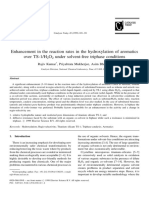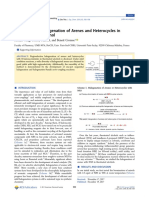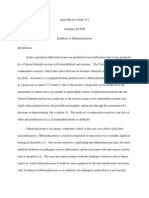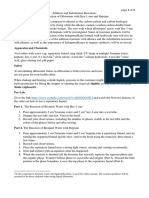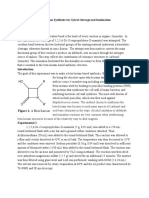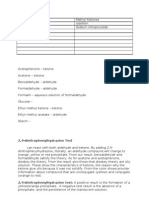Aldehyde and Ketone Condensation Catalyzed by Boric Acid: Mrs. L. For I11 (Cis, Trans, Trans), I11 (Cis, Cis, Cis)
Aldehyde and Ketone Condensation Catalyzed by Boric Acid: Mrs. L. For I11 (Cis, Trans, Trans), I11 (Cis, Cis, Cis)
Uploaded by
EMMANUEL BETANCUR ZAPATACopyright:
Available Formats
Aldehyde and Ketone Condensation Catalyzed by Boric Acid: Mrs. L. For I11 (Cis, Trans, Trans), I11 (Cis, Cis, Cis)
Aldehyde and Ketone Condensation Catalyzed by Boric Acid: Mrs. L. For I11 (Cis, Trans, Trans), I11 (Cis, Cis, Cis)
Uploaded by
EMMANUEL BETANCUR ZAPATAOriginal Title
Copyright
Available Formats
Share this document
Did you find this document useful?
Is this content inappropriate?
Copyright:
Available Formats
Aldehyde and Ketone Condensation Catalyzed by Boric Acid: Mrs. L. For I11 (Cis, Trans, Trans), I11 (Cis, Cis, Cis)
Aldehyde and Ketone Condensation Catalyzed by Boric Acid: Mrs. L. For I11 (Cis, Trans, Trans), I11 (Cis, Cis, Cis)
Uploaded by
EMMANUEL BETANCUR ZAPATACopyright:
Available Formats
Vol. $3, No.
2, F e b m r y 1968 ALDEHYDE REACTIONS775
AND KETONECONDENSATION
Registry No.-I, 1871-53-0; 11, 1002-35-3; I11 Acknowledgment.-The authors wish to thank Mrs.
(all trans) , 15192-80-0; I11 (cis,trans,trans),14947- Joy Buell for invaluable service in interpreting and
19-4; I11 (cis,cis,cis), 14947-20-7; IVb, 14947-21-8; compiling the nmr data and Mr. B. L. Martin for
IVC, 14947-22-9; VI, 15077-07-3. competent assistance.
Aldehyde and Ketone Condensation Reactions Catalyzed by Boric Acid
ROBERTD. OFFENHAUER’ F. NELSEN
AND STEPHEN
Mob2 Research and Development Corporation, Central Research Division Laboratory, Princeton, New Jersey 08640
Received May 4, 1967
Aldol condensation and dehydration reactions using boric acid, boron oxide and lO-hydroxy-lO,%boroxa-
rophenanthrene as catalysts were studied. Heptanal (1) gave 2-pentyl-2-nonenal (2) nearly quantitatively.
Acetophenone (3) gave trans-1,3-diphenyl-2-buten-l-one (4). Benzaldehyde (S), 4methoxybenzaldehyde (a),
and hitrobenzaldehyde (7) each reacted with 3 to give lI3-diphenyl-2-propen-l-one (8) and substituted de-
rivatives. Acetophenone 3 reacted a t equal rates with both components of mixtures of 5 with 6 and 5 with
7, suggesting that the rate-determining step involved only 3. Competitive reactions of nonanal (10) with
heptanal-2,2-d~(12) showed a deuterium isotope effect of 4. An enol borate or a partial enol borate is sug-
gested as an intermediate, the formation of which is rate determining.
Wayne and A d k i d have cited a variety of acids
and bases which catalyze the aldol condensation of
ketones and subsequent dehydration to form a,p-un-
saturated ketones. They further observed that alu-
minum t-butoxide had advantages over many of these
reagents. Both the condensation and dehydration
occurred in one step, the alkoxide acting both as (5) , 4-methoxybenzaldehyde (6), and bnitrobenzalde-
catalyst for the condensation and as dehydrating hyde (7) each reacted with 3 to give 1,3-diphenyl-2-
agent. In the latter step, inactive products are propen-l-one (8) and substituted derivatives in high
formed from the catalyst. They generally obtained yield.
high yields of the desired products. In some cases, Most of the work involved the use of boric acid
however, small amounts of high molecular weight and a solvent such as m-xylene which allowed water
products were formed. Further, they found i t neces- removal through the use of a Dean-Stark trap. Boric
sary to use a t least 1 mole of the alkoxide for 3 moles acid was only slightly soluble in this system. Varying
of the ketone. the amount of the catalyst used had little, if any, effect
Kuivila and coworkers13in a study of the reduction on the reaction rates, suggesting that only the soluble
of carbonyl compounds with isopropyl borate, re- portion was effective as a catalyst.
ported, in the case of heptanol (l), that 2-pentyl-2- Increasing the concentration of 1 relative to the
nonenal (2) was formed through condensation and solvent markedly increased the rate of reaction. I n
dehydration in greater yield (20.5%) than that of the several experiments with 1 using no solvent, but a
reduced product, heptanaI (17.5%). A large amount stream of nitrogen to remove the water formed, the
of higher molecular weight “condensation product” rate of formation of 2 was increased greatly. Con-
was also reported. version of 1 was complete in 2 hr as opposed to about
Now, a convenient and efficient method has been 18-20 hr when m-xylene was used as solvent. It
found for condensing aldehydes and ketones using seems probable that the rate in these cases was lim-
boric acid or boron oxide as catalyst. The a,p-un- ited by the efficiency of water removal. Boric acid
saturated aldehydes and ketones produced did not was completely soluble in the medium in these experi-
react further. This resulted in high yields of the ments. In the absence of a solvent, however, a
primary condensation products. variety of products were formed from 1 in addition
Heptanal 1 under dehydrating conditions which to 2. Similarly, 3 when heated with boric acid in the
existed (1) when boric acid was used and water was absence of a solvent reacted much more rapidly to
azeotropically removed or (2) when a molar quantity give the expected 4, but again yielded a by-product.
of (‘porous’’ boron oxide4 was used gave nearly quan- The selectivity of the catalyst is demonstrated by
titative yields of 2-pentyl-2-nonenal2. Acetophenone an attempt to react the unsaturated aldehyde 2 with
cyclohexanone (9). At the termination of the reac-
CH,CHZCH~CH&H~CH,CH=C-CHO tion, all of the 9 had disappeared to form a compli-
CHaCH&HzCHz Hs
2
c: cated mixture of products. At the same stage, none
of the aldehyde 2 had undergone reaction.
The use of boron oxide as both catalyst and dehy-
(3) reacted slowly by the first method to give only drating agent potentially increases the versatility of
trans-l,%dipheny1-2-buten-l-one (4). Benzaldehyde the reaction by allowing the use of reactants such as
acetone, etc., from which it is difficult to remove
(1) Author to whom inquiries should be directed. water. Knowledge of this variation to date is limited
(2) W. Wayne and H. Adkins, J . Am. Chsm. Soc., 62, 3401 (1940).
(3) H. G. Kuivila, 6. C. Black, and Pentti Siiteri, ibid., T8, 123 (1951).
to 1 which gave a quantitative yield of 2 in 24 hr in
( 4 ) Willy h u g e , Inorg. Sun., 2. 22 (1948). refluxing dioxane.
776 OFFENHAUER
AND NELSEN The Journal of Organic Chemistry
TABLEI
REACTIONS
OF BENZALDEHYDES
WITH ACETOPHENONE
Time, hr
___--___
Benzaldehyde Acetophenone Product
Vpc peak areaa. %
4-Methoxyhenzaldehyde Acetophenone Product 4-Nitrobenzaldehydeo
-_I__
Acetophenone
0 (theory) 8.6 9.8 10.8 9.6 11.9 9.4
0 (found) 7.4 9.2 8.9 9.4 8.7 8.7
17 2.6 3.6 6.5 5.0 4.9
5.5 6.5 6.7
41 1.1 1.2 10.5 2.5 2.6
9.0 5.8 5.4
65 0.5 0.5 11.4 1.0 10.1
1.1 4.5 3.9
00 (theory) 17.2 19.2
The 4-nitrobenzalacetophenonewas insoluble in the cooled samples, therefore did not appear in the vpc.
TABLEI1
COMPETITIVE REACTIONS
OF BENZALDEHYDE
AND 4METHOXYBENZALDEHYDE WITH ACETOPHENONE
,--__ --- Vpc peak aream, %- --.
Time, hr Benzaldehyde 4-Methoxybenzaldehyde Acetophenone Benzalacetophenone 4-Methoxybenzalacetophenone
0 (theory) 4.3 5.5 9.7
0 (found) 4.1 4.6 9.1
6 2.4 2.9 6.2 1.9 1.9
24 0.5 1.0 2.1 6.8 6.8
10-Hydroxy-lO,9-boroxarophenanthrenesalso con- TABLEI11
verts heptanal into 2-pentyl-2-nonenal quantitatively. COMPETITIVEREACTIONSOF BENZALDEHYDE
AND
The effect on the over-all rate of deuterating alde- 4NITROBENZALDEHYDE WITH ACETOPHENONE
hyde 1 in the a positions was determined. It was 7-- Vpc peak areas, %
4-Nitro- Benzal-
felt, since the reactor used was not suited to precise Time, hr Benzaldehyde benzaldehyde0 Acetophenone acetophenone
studies of rate, that an internal competition would 0 (theory) 4.2 6.1 9.6
be most meaningful. Accordingly, the condensation 0 (found) 3.7 4.3 8.6
of a mixture of I with nonanal (IO) was studied by 1.5 3.4 3.5 7.8
the same method used for 1 alone. Analysis of the 5 2.6 2.6 6.2
products by vapor phase chromatography (vpc) gave 22 1.1 0.6 1.1 9.6
three peaks. The first was 2. The last was 2-heptyl- a 4-Nitrobenzalacetophenone was insoluble, not determined.
2-undecenal (11) identified by comparison of its vpc
retention time with the same material prepared by being rate controlling since the rate of dehydration
condensation of aldehyde 10 alone. The intermedi- would almost certainly be influenced by the polar
ate peak was assumed to be an equimolar mixture groups. Further, they suggest that the rate-control-
of the two possible mixed condensation products. ling step involves only acetophenone 3. These results
The per cent peak areas of 3.1:6.7:3.8 checked very are consistent with the possibility that an enol borate
closely to those expected from completely random or partial enol borate is an intermediate and that the
reaction; i.e., 1 :2: 1 on a molar basis. Heptana1-2,2-& formation of the enol borate is the rate-controlling
(12) was then condensed similarly with 10. Three step in this condensation. There is, however, no
peaks were again obtained, but not in a 1 :2: 1 ratio. direct evidence for this proposed intermediate.
Determination of the ratio of 11 to the 2-pentyl-2- Simple enol borates (except some tetrahedral co-
nonenal-4,4-d2 (13) produced from 12 was made a t ordinate compounds) have not been reported.6a A re-
several reaction times. Extrapolation of the ratio lated product, dibromovinyl diethylborate, has, how-
back to zero time showed a 4: 1 initial preference for ever, been reported by Meerwein.6
inclusion of 10 rather than 12 in the condensation
products. Experimental Section
Further information was obtained from the reaction
of benzaldehyde 5, 4-methoxybenzaldehyde 6, and 4- All melting points are corrected. Vpc analyses were run
on a 10 ft X ‘/sin. silicone rubber column in an F & M Model
nitrobenzaldehyde 7 with acetophenone 3. Table I 720 chromatograph. Boric acid was from J. T. Baker and wm
shows the results. Both 6 and 7 reacted measurably recrystallized from water before use. All other chemicals were
slower than did the unsubstituted 5. I n competitive from Matheson Coleman and Bell. Heptanal, nonanal, and
condensations between 5 and 6 and between 5 and 7 benzaldehyde were purified by forming the sodium bisulfite
using molar ratios of 5 to 6 to 3 and of 5 to 7 to 3 of addition compounds, washing with ether, decomposing the
adduct with cold NaOH, and distilling in a rotary evaporator.
1 :2: 1, each aldehyde disappeared at very marly the Acetophenone was distilled in the rotary evaporator. Other
same rate as its competitor, the over-all rate being chemicals were used as obtained. Dioxane was Chromato-
nearly the same as when 5 alone was used. These quality Reagent grade.
results are shown in Tables I1 and 111. Condensation of Heptanal ( 1 ) . 1.-A stirred mixture of
37.6 g (0.33 mole) of heptanal ( l ) , 12.4 g of boric acid (0.2
The results with the deuterated aldehyde 12 showed mole),’ and 220 g of m-xylene was refluxed using a Dean-Stark
a step involving scission of the a-hydrogen-carbon -
(6) (a) H. Steinberg, “Organoboron Chemistry,” Vol. I, John Wiley
bond to be rate controlling. Making the reasonable and Sons, Inc.. New York. N. Y., 1964, pp 27,523-525. (b) H. Meerwein,
assumption that this would also hold true for the G. Hinz, H. Majert, and H. Sonke, J . Prakt. Chcm., 147, 226 (1936).
aldehyde-ketone condensations, these results with the (7) Far less boric acid could be used. In another experiment, identioal
except that only 0.02 M of catalyst was used, a nearly quantitative yield of S
benzaldehydes eliminate the dehydration step as was formed a t the same rate as when the larger amount of boric acid waa
uaed. No attempt was made to determine the minimum amount of catalyst
(5) M. J. S. Dewar and R. Dietz, Tetrahedron Letlera, 14, 21 (1959). that could be used.
Vol. $8, No. 2, Febmay 1968 ALDEHYDE REACTIONS777
AND KETONECONDENSATION
trap to remove water. The volume of wateF collected agreed that very little loss of 1 had occurred. Another 50 g of Dz0
with vpc in every case as a method for following the degree of and 200 mg of 14 were added and refluxing was continued for
completion of reaction. Vpc showed that a small amount of 2 20 hr. After cooling, 20 g of Amberlyst 1 5 , l 6 which had been
had been formed after 1 hr. After 18 hr, the 1had disappeared swelled with water and washed with dioxane was added, stirred
and conversion to product was complete.8 By comparison for 6 min, and filtered. This treatment had been shown to
with a standard sample of the product in m-xylene, the yield remove effectively the amine and not to destroy heptanal.
of 2 was shown to be nearly quantitative. No higher boiling Water and D2O were again removed by stirring with 40 g of
products were formed. The product was isolated by filtering MgSO, for 1 hr and filtering. Vpc showed the filtrate to
to remove boron oxides and distilling the filtrate in a 45 cm X contain (neglecting the dioxane) 85% of 1 and/or 12 and 15%
0.6 cm spinning band column. The fraction boiling a t 86-87' of 2. Distillation in a 45 cm X 0.6 cm spinning-band column
(1 mm) was identified by comparison of its infrared spectrum afforded 9.9 g of product, b p 56-57' (25 mm). From the nmr
with a reported spectrum9 and formation of its 2,4-dinitro- spectrum, it was estimated that this product was a 1-12 mix-
phenylhydrazone, m p 129.5-130.5". The 2,4-dinitrophenyl- ture containing a minimum of 93% of the deuterated species.
hydrazone of 2 reported by Fuller and Kinglo had m p 129'. Condensation of Nonanal (IO).--Condensation of 10 in
2.-An 18.6-g (0.3 mole) sample of boric acid was dehydrated xylene solution in the presence of boric acid was carried out
by heating over several hours u p to 192' (1 mm) in a rotating in the same way as was the condensation of 1. The product,
evaporator. This treatment produced 10.1 g (ca. 0.15 mole) 11, was identified by the similarity of its infrared spectrum
of "porous" boron oxide. Traces of boron compounds were with that of 2 and by the method used in its preparation. The
lost through entrainment. A solution of 50 g of dioxane and vpc retention time was 8.7 min under conditions which gave
22.8 g (0.2 mole) of 1 was added and refluxed with stirring a retention time of 7.2 min for 2.
for 22 hr. At this point a translucent brown solid adhered to Condensation of Heptanal (1) with Nonanal (lo).-A mix-
the sides of the flask. Vpc analysis of the supernatant liquid ture of 1.14 g (0.01 mole) of 1, 1.42 g (0.01 mole) of 10, 10 g
showed it to be pure dioxane. To the cooled mixture, 2 ml of m-xylene and 0.5 g (0.009 mole) of boric acid was stirred
of HzO was added. A voluminous colorless solid formed. and refluxed for 24 hr. Vpc analysis (by peak areas) showed
Vpc of the liquid portion showed, by comparison with a 3.1% of a product at a retention time of 9.4 min, 6.7% at
standard solution of the product, that a nearly quantitative 10.4 min, and 3.8% at 11.4 min. These correspond, respec-
yield of 2 had been formed. tively, very closely to the expected ratios for 2, the two mixed
3.-A solution of 3.8 g of 1, 10 g of m-xylene, and 0.5 g of 10- condensation products, and 11.
hydroxy-l0,9-boroxarophenanthrene&was refluxed using a Dean- Condensation of Heptanal-2,2-d2 (12) with Nonanal (IO).-
Stark trap. After 12 hr, 1 had disappeared and conversion into A mixture of 1.93 g (0.017 mole) of 12, 2.38 g (0.017 mole) of
2 as measured by vpc was complete. By comparison with a 10, 0.81 g (0.013 mole) of boric acid, and 20 g of toluene was
standard sample of the product in m-xylene, the yield of 2 was stirred and refluxed. The ratio of per cent peak areas by
shown to be nearly quantitative. vpc of 11-13 were a t 1.5 hr, 4; at 3 hr, 3.5; at 7 hr, 2.8; at 13 hr,
Condensation of Acetophenone (3). 1.-A stirred mixture 2.4; and a t 24 hr, 1.8. Correcting by multiplying by the
of 2.4 g (0.02 mole) of 3 , l O . O g of m-xylene, and 0.5 g (0.01 mole) inverse of the 11 to 2 ratio or 3J/3.a from the preceding experi-
of boric acid was refluxed for 47 hr using a Dean-Stark trap. ment to convert from a weight to a molar basis and extrapolat-
Vpc showed that 4 was formed in 18% yield. The yield was ing to 0 time gives an isotope effect of about 4.
determined by comparison with a standard solution. Identifi- Reaction of Benzaldehyde (5) with Acetophenone (3).-A
cation was made by trapping a sample from the vpc and com- mixture of 10.6 g (0.1 mole) of 5, 12.0 g (0.1 mole) of 3, 6.2 g
paring its infrared spectrum with that of a reported spectrum.lI (0.1 mole) of boric acid and 100 g of m-xylene was stirred and
2.-A stirred mixture of 10.0 g (0.08 mole) of 3 and 0.5 g refluxed. Results of vpc analyses ( % peak areas) at various
(0.01 mole) of boric acid was refluxed. After 10 hr, three times are shown in Table I. After 65 hr the product was
products were present in the following amounts calculated cooled and treated with water and ether. The organic layer
from vpc per cent peak areas: 3, 31 % a t a retention time of 6.6 was evaporated in vacuo and the solid product triturated with
min, an unknown, 6% at 11.1 min, and 4, 63% a t 12.2 min. petroleum ether (bp 30-60'). Bensalacetophenone ( 8 ) (15.4 g,
The last was identified as above. By comparison with a known 74.0%) was obtained, mp 60-62'.
infrared spectrum,IZ the unknown product was shown not to be Reaction of 4-Methoxybenzaldehyde (6) with Acetophenone
cis-l,3-diphenyl-2-buten-l-one. (3).-This reaction was carried out in a fashion identical with
Attempted Reaction of 2-Pentyl-2-nonenal(2) with Cyclohex- that for 5. Results of vpc analyses are given in Table I. The
anone (9).-A mixture of 19.6 g (0.2 mole) of 9, 5.0 g of 2, 1.2 g product was 18.4 g (77.3 %) of 4-methoxybenzalacetophenone
of boric acid, and 100 g of toluene was refluxed for 24 hr. Vpc (15), mp 76-78".
showed that all of the 9 had reacted forming a complicated Reaction of 4-Nitrobenzaldehyde (7) with Acetophenone (3).
spectrum of products, but none of the 2 had reacted. -This reaction was carried out as above. Results of vpc
Deuteration of Heptanal (l).IS-A solution of 25 g of 1, analyses are given in Table I. The product was only partially
250 g dioxane, 625 mg of 1,2-dihydro-l-methyl-2-methylimino- soluble in ether. The insoluble portion was filtered and com-
pyridine ( 14),14and 50 g of DzO was refluxed for 18 hr. The bined with the soluble portion obtained from the filtrate by
solution was cooled; 40 g of MgSO+was added to remove water evaporation of the solvents and trituration with a small quan-
and DzO, and it was stirred for 1 hr and filtered. Vpc showed tity of ether. 4-Nitrobenzalacetophenone (16) (9.8 g, 39%)
(8) A curious observation was made on several occasions during runs
was obtained, m p 163-166".
similar to that described. The vpc peaks of the products increased regularly Competitive Condensation. Benzaldehyde (5) va. 4-Meth-
with time, then gradually disappeared. At the time when all of the aldehyde oxybenzaldehyde with Acetophenone (3).-A mixture of 5.3 g
had undergone reaction, the only product appearing in the vpc was the (0.05 mole) of 5, 6.8 g (0.05 mole) of 6, 12.0 g (0.1 mole) of 3,
solvent. At this point, addition of enough water to dissolve the boron 6.2 g (0.1 mole) of boric acid, and 100 g of m-xylene was stirred
oxides caused the expected amount of products to reappear in the vpc. and refluxed. Results of vpc analysis a t various times are
One attempt was made to isolate the presumed unsaturated aldehyde-boron shown in Table 11.
oxide combination b y filtration. No special precautions were taken to Competitive Condensation. Benzaldehyde (5) us. 4-Nitro-
exclude moisture. The precipitate was washed with pentane. The result-
ing boron oxide was free of organic material and the product 4 was found in
benzaldehyde (7) with Acetophenone (3).-This reaction was
the filtrate. It is not understood a t this time in what wa) the "normal" run in the same way as the preceding one except that 7.6 g
runs differ from those few runs in which the product did not appear in the (0.05 mole) of 7 was used instead of 6. Results appear in
vpc. Table 111.
(9) Sadtler Research Laboratories, Philadelphia, Pa., Infrared Spectrum
No. 652. Registry No.-1, 111-71-7; 2,3021-89-4; 3, 98-86-2;
(10) A. T. Fuller and H. King, J . Chem. Soc., 963 (1947). 5, 100-52-7; 6, 123-11-5; 7, 555-16-8; 8, 94-41-7;
(11) Sadtler Research Laboratories, Philadelphia, Pa., Infrared Spectrum
No. 8687. 9,108-94-1 ; 10,124-19-6; 12,15040-89-8; IS, 959-33-1;
(12) R. E. Lutz and L. T. Slade, J . Org. Chem., 46, 4888 (1961). boric acid, 10043-35-3.
(13) D. N. Kurssnov and Z. N. Parnes, DokL Akad. Nrruk SSSR 10% 847
(1955): Chem. Abalr., 60, 932e (1956). (15) The acid form of a highly porous sulfonated polystyrene cation
(14) A. E. Techitachibabin and R. A. Konowalowa, Ber., 69, 2055 (1926). exchange renin obtained from Rohm and Haas Co.. Philadelphia, Pa.
You might also like
- Chm557 Laboratory Report: Experiment 4 The Aldol Condensation Reaction: Preparation of DibenzalacetoneDocument17 pagesChm557 Laboratory Report: Experiment 4 The Aldol Condensation Reaction: Preparation of DibenzalacetonesyafNo ratings yet
- Benzylidene AcetalDocument9 pagesBenzylidene AcetalsadiaNo ratings yet
- Preparation of IodoformDocument3 pagesPreparation of Iodoformjerry green67% (3)
- Mundal 2012Document4 pagesMundal 2012HugoNo ratings yet
- Synthesis of 2-Amino-1-Phenyl-1-Propanol and Its Methyl at Ed Derivatives'Document4 pagesSynthesis of 2-Amino-1-Phenyl-1-Propanol and Its Methyl at Ed Derivatives'gardner8850% (2)
- Enhancement in The Reaction Rates in The HydroxylationDocument7 pagesEnhancement in The Reaction Rates in The HydroxylationAnkit MaharshiNo ratings yet
- J. Org. Chem., 2018, 83 (2), PP 930-938 (Halogenation in HFIP)Document9 pagesJ. Org. Chem., 2018, 83 (2), PP 930-938 (Halogenation in HFIP)ludoNo ratings yet
- 20 - One-Pot Synthesis of A, B-Epoxy Ketones by Palladium-CatalyzedDocument3 pages20 - One-Pot Synthesis of A, B-Epoxy Ketones by Palladium-CatalyzedInes DaoudiNo ratings yet
- Macdougall 1996Document12 pagesMacdougall 1996jfjd6889No ratings yet
- 10 1002@ (Sici) 1521-3765 (19990401) 5:4 1320::aid-Chem1320 3 0 Co 2-#Document11 pages10 1002@ (Sici) 1521-3765 (19990401) 5:4 1320::aid-Chem1320 3 0 Co 2-#Yassine SabekNo ratings yet
- Homoacetogenesis As The Alternative Pathway For HDocument7 pagesHomoacetogenesis As The Alternative Pathway For HProfessor Douglas TorresNo ratings yet
- Chem213 Formal Final Report 2Document14 pagesChem213 Formal Final Report 2Amanda Long100% (2)
- Sintesis de CineolDocument4 pagesSintesis de CineolNatalia RuizNo ratings yet
- Chem-No.-13 2Document5 pagesChem-No.-13 2ho laNo ratings yet
- H2o2 Radical BrominationDocument3 pagesH2o2 Radical BrominationJuan PerezNo ratings yet
- Chen 2015Document8 pagesChen 2015Mohammad AhedNo ratings yet
- Hydroformylation of 1 OcteneDocument6 pagesHydroformylation of 1 OcteneLucas TorregrosaNo ratings yet
- Active Methylene Compounds1-S2.0-S0040402012007971-MainDocument6 pagesActive Methylene Compounds1-S2.0-S0040402012007971-MainSeren ModNo ratings yet
- The Carbohydrates The Jerusalem Artichoke and Other CompositaeDocument13 pagesThe Carbohydrates The Jerusalem Artichoke and Other CompositaesnehasonaliNo ratings yet
- 1 s2.0 S0040403913009131 MainDocument3 pages1 s2.0 S0040403913009131 Mainkadirek555No ratings yet
- 1 s2.0 S0040403906014444 Main PDFDocument3 pages1 s2.0 S0040403906014444 Main PDFPrasanth BitlaNo ratings yet
- The Room Temperature Polymerization of Propylene OxideDocument5 pagesThe Room Temperature Polymerization of Propylene OxidecesarmachucaNo ratings yet
- A Simple One-Step Conversion Carboxylic Acids To Esters UsingDocument3 pagesA Simple One-Step Conversion Carboxylic Acids To Esters UsingAnonymous m35iKgHNo ratings yet
- 10.1002.poc.1483 Hydrolysis of DiketeneDocument5 pages10.1002.poc.1483 Hydrolysis of Diketenemrio0069No ratings yet
- Evering 1953Document8 pagesEvering 1953vahidNo ratings yet
- A-Phenyltropic Acid and Basic Esters.-Catalyzed Reactions of oYDiphenyl-p-propiolactoneand of 2 2-Diphenyl-3-Bromo - and Chloropropanoic AcidsDocument4 pagesA-Phenyltropic Acid and Basic Esters.-Catalyzed Reactions of oYDiphenyl-p-propiolactoneand of 2 2-Diphenyl-3-Bromo - and Chloropropanoic AcidsTHEUSER0001No ratings yet
- Ron Chin 1997Document13 pagesRon Chin 1997alchemy090909No ratings yet
- Hydrolisis of EthanodiolDocument6 pagesHydrolisis of Ethanodiolchama_gozNo ratings yet
- Gislason 2002Document8 pagesGislason 2002vanessa jimenezNo ratings yet
- Santoro Et Al-2008-Advanced Synthesis & CatalysisDocument4 pagesSantoro Et Al-2008-Advanced Synthesis & CatalysisIsa Guerrero TroyanoNo ratings yet
- A New Route For Ethylene Glycol Metabolism in Mycobacterium E44Document7 pagesA New Route For Ethylene Glycol Metabolism in Mycobacterium E44வேல் முருகன்No ratings yet
- ffr2 63Document6 pagesffr2 63api-253517612No ratings yet
- Chemistry OrgDocument4 pagesChemistry OrgbondiitkgpNo ratings yet
- A General Method For C Reductive Alkylation of Indoles: Anu Mahadevan, Howard Sard, Mario Gonzalez and John C. MckewDocument3 pagesA General Method For C Reductive Alkylation of Indoles: Anu Mahadevan, Howard Sard, Mario Gonzalez and John C. MckewMichell UrzúaNo ratings yet
- The Estimation of The Available Lysine in Animal-Protein FoodsDocument7 pagesThe Estimation of The Available Lysine in Animal-Protein Foodsdd11rrttyyNo ratings yet
- (Bogert M. T., Nisson Ph. S.) Further ExperimentsDocument8 pages(Bogert M. T., Nisson Ph. S.) Further ExperimentsFredrik KepelNo ratings yet
- Barrow Lab ReportDocument6 pagesBarrow Lab Reportapi-198895639No ratings yet
- Reactions of Aldehydes and Ketones: Learning Activity No. 17Document28 pagesReactions of Aldehydes and Ketones: Learning Activity No. 17angeline medallo100% (1)
- 5 BiocatDocument4 pages5 BiocatPanjabrao ChavanNo ratings yet
- Hetero Cyclic CompoundsDocument22 pagesHetero Cyclic Compoundsdaus029445100% (1)
- Ammonium Nickel Sulfate (Tuttons Salt) Mediated Rapid and Facile Synthesis of Schiff Base Under Environmental Friendly ConditionDocument9 pagesAmmonium Nickel Sulfate (Tuttons Salt) Mediated Rapid and Facile Synthesis of Schiff Base Under Environmental Friendly ConditionIJAR JOURNALNo ratings yet
- Communications: Dehydrogenative CouplingDocument5 pagesCommunications: Dehydrogenative CouplingLakshay KathuriaNo ratings yet
- Cita 2fotocatalisisDocument9 pagesCita 2fotocatalisisSkade JötunheimNo ratings yet
- Chem 305 Lab OneDocument6 pagesChem 305 Lab OneGobe JamNo ratings yet
- Exp Addition Substitution Ver03Document2 pagesExp Addition Substitution Ver03clappedNo ratings yet
- Ajc 24 3 90Document3 pagesAjc 24 3 90Thanh VyNo ratings yet
- Transformation of Phenol Into Phenylalanine by A Methanogenic ConsortiumDocument6 pagesTransformation of Phenol Into Phenylalanine by A Methanogenic ConsortiumCao Thị Vân GiangNo ratings yet
- 1 s2.0 S0009261420308459 MainDocument6 pages1 s2.0 S0009261420308459 MainrousymelinaNo ratings yet
- Photochemical Generation and Lifetimes in Water of P-Aryloxy - and P-Alkoxyphenylnitrenium IonsDocument8 pagesPhotochemical Generation and Lifetimes in Water of P-Aryloxy - and P-Alkoxyphenylnitrenium IonskawtherahmedNo ratings yet
- 1-S2.0-S1872206718631390-Main ARTICULODocument5 pages1-S2.0-S1872206718631390-Main ARTICULOLeiny SaaNo ratings yet
- Haberfield 1969Document3 pagesHaberfield 1969Saurav PaulNo ratings yet
- Triphenylphosphine Dibromide A Simple One-Pot Esterification ReagentDocument16 pagesTriphenylphosphine Dibromide A Simple One-Pot Esterification ReagentRasha El-GhazawyNo ratings yet
- Lim 20071Document5 pagesLim 20071gregorbanalt1No ratings yet
- A Portion of The: 0 CBHB-CH-CH CSHJ - CH - CH Vi1 Vi11 - Ch-C&IDocument3 pagesA Portion of The: 0 CBHB-CH-CH CSHJ - CH - CH Vi1 Vi11 - Ch-C&IJaime GonzalezNo ratings yet
- OrgochemsampleworkDocument10 pagesOrgochemsampleworkMakcaNo ratings yet
- 1 s2.0 S0960894X22003213 MainDocument5 pages1 s2.0 S0960894X22003213 Maingabriel martinezNo ratings yet
- Tetrahedron Letters 52 (2011) 5107-5109Document3 pagesTetrahedron Letters 52 (2011) 5107-5109rajesh_tammana3550No ratings yet
- Solvent Free Claisen and Cannizzaro ReactionsDocument3 pagesSolvent Free Claisen and Cannizzaro ReactionsCésar Andrés Rodríguez100% (1)
- O A T A O Oatao: Pen Rchive Oulouse Rchive UverteDocument16 pagesO A T A O Oatao: Pen Rchive Oulouse Rchive UverteamirulhaqimNo ratings yet
- The Total Synthesis of Natural ProductsFrom EverandThe Total Synthesis of Natural ProductsJohn ApSimonNo ratings yet
- Sustainable synthesis of ciclopentene derivatives through multicomponent reactions in continuous flow regimeFrom EverandSustainable synthesis of ciclopentene derivatives through multicomponent reactions in continuous flow regimeNo ratings yet
- June 2011 UnsolvedDocument22 pagesJune 2011 UnsolvedAamerNo ratings yet
- Alan R. Katritzky, Otto Meth-Cohn, And Charles W. Rees (Editors-In-Chief)-Comprehensive Organic Functional Group Transformations, Volume 3 (Synthesis_Carbon With One Heteroatom Attached by a MultipleDocument850 pagesAlan R. Katritzky, Otto Meth-Cohn, And Charles W. Rees (Editors-In-Chief)-Comprehensive Organic Functional Group Transformations, Volume 3 (Synthesis_Carbon With One Heteroatom Attached by a Multipleravichem823No ratings yet
- CF Aiats 04 A 2022-01-23 2021 ADocument19 pagesCF Aiats 04 A 2022-01-23 2021 AkarnNo ratings yet
- Aldehydes Ketones Carboxylic AcidsDocument40 pagesAldehydes Ketones Carboxylic AcidsAlexandrea WynnoevahNo ratings yet
- KCET 2024 Chemistry Study Plan PDFDocument5 pagesKCET 2024 Chemistry Study Plan PDFshirishgt02No ratings yet
- Org Chem Ost LabDocument21 pagesOrg Chem Ost Labjullian marasiganNo ratings yet
- NSSCAS Chemistry Theme 4 Topic 4.5 - 4.6 - 4.7 - Updated 05 November 2020Document71 pagesNSSCAS Chemistry Theme 4 Topic 4.5 - 4.6 - 4.7 - Updated 05 November 2020sikereteromanus9No ratings yet
- Articulo 10.-Boric Acid As A Green Catalyst For The Conversion of Aldehydes and KetonesDocument8 pagesArticulo 10.-Boric Acid As A Green Catalyst For The Conversion of Aldehydes and KetonesPaul Delgado MendozaNo ratings yet
- Subject Chemistry: Paper No and Title 5 Organic Chemistry-II Module No and Title 25 S 1 Reactions Module Tag CHE - P5 - M25Document11 pagesSubject Chemistry: Paper No and Title 5 Organic Chemistry-II Module No and Title 25 S 1 Reactions Module Tag CHE - P5 - M25Kamrujjaman Kamran100% (1)
- Photo Nazarov OL 2021Document6 pagesPhoto Nazarov OL 2021OscarNo ratings yet
- AldehydesDocument9 pagesAldehydesNadine Jamih100% (2)
- Aldehydes, Ketones and Carboxylic Acid DPP-2Document2 pagesAldehydes, Ketones and Carboxylic Acid DPP-2geetabanga69937No ratings yet
- General Chemistry 1 Qt. 2 Week 5Document31 pagesGeneral Chemistry 1 Qt. 2 Week 5Nina Reca OmisolNo ratings yet
- Socl N Ag R-Cooh - R-Cocl - R-Cochn - R-CH Conu Ether, Et N Nucleophile (Nu)Document37 pagesSocl N Ag R-Cooh - R-Cocl - R-Cochn - R-CH Conu Ether, Et N Nucleophile (Nu)Shanmugam RameshNo ratings yet
- Functional Group AnalysisDocument20 pagesFunctional Group AnalysisandreaNo ratings yet
- Reactions of TrichlorotriazineDocument16 pagesReactions of Trichlorotriazinebebo4gpaNo ratings yet
- 5 JeeDocument14 pages5 JeeYaswanth PedapudiNo ratings yet
- Neet Lesson Plan - ChemDocument16 pagesNeet Lesson Plan - ChemVishwa NathNo ratings yet
- Intermediates For Organic Synthesis, 1/e: Book Information Sheet Book Information SheetDocument1 pageIntermediates For Organic Synthesis, 1/e: Book Information Sheet Book Information SheetAranga0% (1)
- Aldehydes & Ketones: (Alkanals & Alkanones)Document41 pagesAldehydes & Ketones: (Alkanals & Alkanones)Hunain NadeemNo ratings yet
- 6.1.2 Carbonyl Compounds QPDocument16 pages6.1.2 Carbonyl Compounds QPhhdhfr8n7qNo ratings yet
- U4 OrganicDocument94 pagesU4 OrganictahabaigNo ratings yet
- V V CARBONYL COMPOUNDS-.SYNOPSISDocument14 pagesV V CARBONYL COMPOUNDS-.SYNOPSISLalitha MarimuthuNo ratings yet
- Rubber Properties Chart PDFDocument1 pageRubber Properties Chart PDFArasarethina KumarNo ratings yet
- Nomenclature of Aldehydes & KetonesDocument8 pagesNomenclature of Aldehydes & KetonesDj Arts Tarpaulin PrintingNo ratings yet
- Functionalgroups 1-WorksheetDocument2 pagesFunctionalgroups 1-WorksheetTaha ZaheerNo ratings yet
- Identifikasi Gugus FungsiDocument42 pagesIdentifikasi Gugus FungsiWhyuuuuuNo ratings yet
- 6-IR Spectroscopy of Alkane, Alkene and Carbonyl CompoundsDocument8 pages6-IR Spectroscopy of Alkane, Alkene and Carbonyl Compoundsbloodhound13042005No ratings yet
- Group 6 Ex#7Document9 pagesGroup 6 Ex#7s2200569No ratings yet





